Native plant terraced fences transform boundaries into stunning ecological assets. You’ll find options like cascading prairie bluestem for privacy, multi-level wildflower systems for pollinators, drought-resistant succulents for arid regions, and woodland fern barriers for shade. Other solutions include seasonal blooming layers, butterfly-attracting screens, xeriscape boundaries, edible berry terraces, and wildlife-supporting borders. These designs combine beauty with functionality while supporting local ecosystems. Discover how these innovative approaches can revolutionize your property line while minimizing maintenance.
Cascading Prairie Bluestem Terraces for Natural Privacy
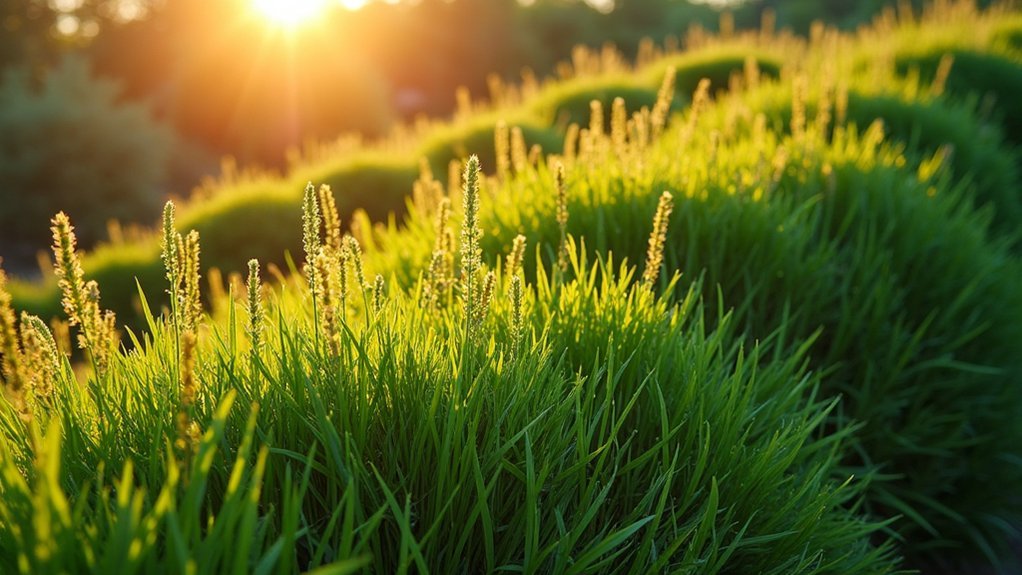
While traditional fencing options dominate suburban landscapes, Cascading Prairie Bluestem terraces offer a stunning alternative that transforms ordinary boundaries into living privacy screens. This impressive native grass grows 4-6 feet tall, creating effective natural barriers when strategically arranged in terraced layers.
You’ll appreciate how this drought-tolerant perennial thrives in challenging conditions while requiring minimal maintenance. Consider installing a series of privacy planter boxes at varying heights to create dramatic cascading effects that capture attention with beautiful, swaying seed heads.
Beyond aesthetics, these grass terraces provide valuable habitat for local wildlife and improve soil health through their extensive root systems.
Multi-Level Wildflower Fence Systems for Pollinators
Three distinct layers of native wildflowers can transform your ordinary fence line into a thriving pollinator paradise. Creating multi-level wildflower fence systems with carefully selected native plants provides continuous blooms while managing erosion and enhancing biodiversity.
| Height Level | Plant Options | Blooming Period |
|---|---|---|
| Ground Cover | Prairie Verbena | Spring-Fall |
| Mid-Level | Lindheimer Muhly | Summer-Winter |
| Climbing | Snapdragon Vine | Spring-Summer |
| Accent | Flame Acanthus | Summer-Fall |
You’ll attract diverse pollinator species by incorporating plants that flower at different times. The vertical structure offers shelter for beneficial insects while creating stunning visual appeal. Mixing perennials with annuals guarantees sustainability and year-round interest. Your fence won’t just define property lines—it’ll become a vibrant pollinator habitat supporting local ecosystems through every season.
Drought-Resistant Succulent Terraces for Arid Climates

In arid regions where water conservation reigns supreme, drought-resistant succulent terraces offer an ingenious solution for fence lines. You’ll appreciate how these hardy plant varieties thrive with minimal irrigation while creating striking visual interest along your property boundaries.
By strategically terracing your fence area, you’re not only preventing soil erosion but also improving drainage during occasional heavy rains.
Choose diverse succulents like Agave and Echeveria that store water in their leaves, enabling them to withstand extended dry periods.
Installing a drip irrigation system enhances efficiency, delivering moisture directly to plant roots without waste.
Your terraced succulent design will attract beneficial insects and promote biodiversity, creating a sustainable ecosystem.
This approach transforms ordinary fence lines into beautiful, low-maintenance landscapes perfect for desert and Mediterranean climates.
Tiered Woodland Fern and Moss Barriers
For shaded landscapes where humidity prevails, tiered woodland fern and moss barriers offer an enchanting alternative to traditional fencing.
You’ll create privacy screens that blend seamlessly with your natural surroundings while supporting local ecosystems.
Native ferns like Japanese Painted and Lady Fern thrive in these moist environments, forming the structural backbone of your living barrier.
Place Cushion Moss between your tiered woodland fern arrangements to create a cohesive, verdant tapestry that retains moisture and reduces maintenance needs.
Beyond their aesthetic appeal, these living barriers promote biodiversity by providing wildlife habitat and stabilizing soil on slopes.
Seasonal Blooming Native Plant Fence Layers
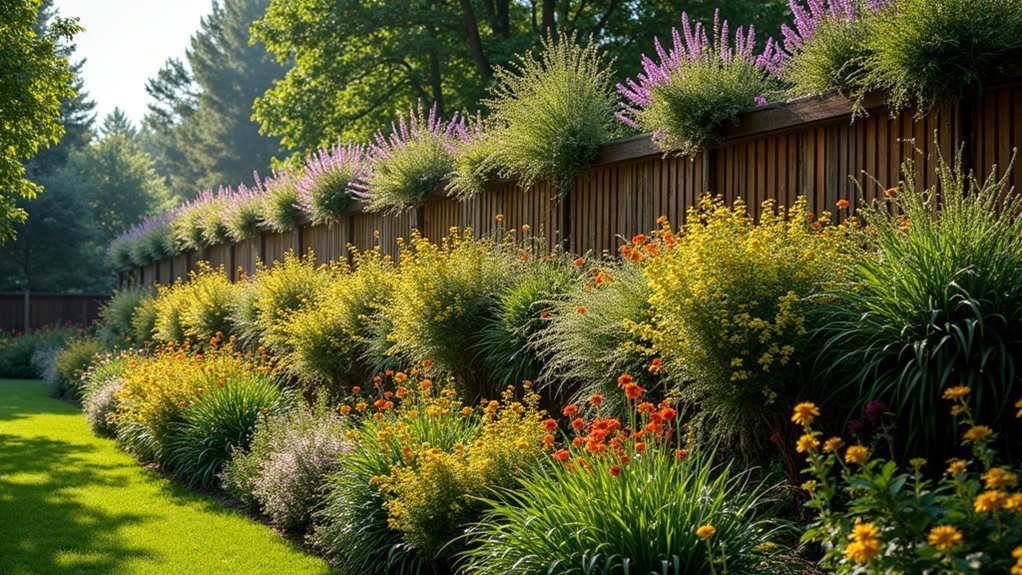
Creating a dynamic fence with seasonal blooming natives transforms your property boundary into a living tapestry that evolves throughout the year.
Start with low-growing species like Muhlenbergia lindheimeri that provide fall texture while supporting local wildlife.
Add vertical interest with climbing plants such as Maurandella antirrhiniflora, which enhances privacy while attracting butterflies during its bloom cycle.
Layer these with mid-height flowering shrubs like Rose of Sharon for summer-to-fall visual appeal and additional structure.
Rain Garden Terraced Fence Integration
You’ll maximize your property’s drainage capacity by incorporating layered systems into your terraced fence rain garden design.
Select drought-tolerant natives for upper levels and moisture-loving species for lower tiers to create a functional water management solution that thrives year-round.
The multi-level approach not only prevents erosion and runoff but also establishes distinct ecological zones that support diverse wildlife within your landscape.
Layered Drainage Systems
While traditional fences simply mark boundaries, layered drainage systems transform this concept by integrating terraced fencing with rain gardens to manage stormwater naturally.
You’ll achieve both functionality and beauty when you incorporate native plants into these systems, creating a sustainable landscape that works with nature rather than against it.
- Terraced fencing directs water flow into strategically placed rain gardens, preventing erosion
- Native plants enhance biodiversity while improving soil health and water filtration
- Permeable materials in your fence design facilitate better water infiltration
- The layered approach provides habitat for local wildlife while managing excess water
Multi-Level Plant Selection
When designing a terraced fence with integrated rain gardens, smart plant selection becomes your most powerful tool for both function and beauty.
Choose adaptable species like Lindheimer Muhly and American Elderberry that thrive in varying moisture conditions while creating lush, multi-level plant selection throughout your terraced space.
For vertical interest and enhancing privacy, incorporate climbing vines such as Mandevilla or climbing hydrangeas that add dimension while softening hard fence lines.
Native ferns and Jade Waves Fernspray False Cypress provide essential texture and help stabilize soil on slopes, preventing erosion in your rain garden system.
Complete your design with dramatic backdrop elements like the Magical Amore Holly, which can reach 20 feet tall and creates striking contrast behind lower plantings while supporting local biodiversity and sustainable drainage solutions.
Butterfly-Attracting Indigenous Plant Screens
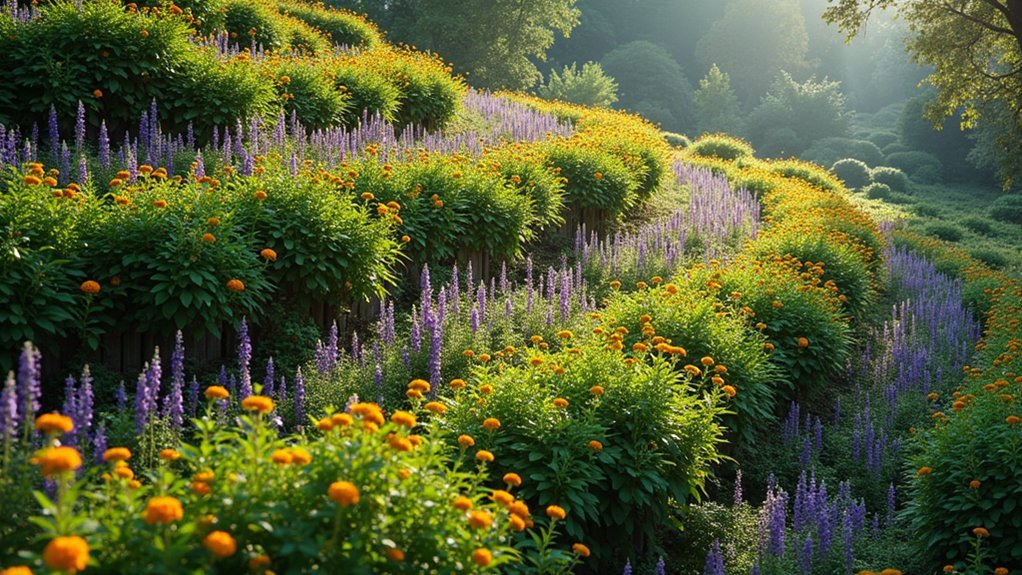
Transforming your fence into a vibrant butterfly sanctuary begins with the strategic incorporation of native flowering plants. Your terraced fence design isn’t just a boundary—it’s an opportunity to support local butterfly populations while enhancing your landscape’s beauty.
Reimagine your boundary as a butterfly haven—where native blooms transform structure into sanctuary.
By selecting indigenous plants like Milkweed, Coneflower, and Black-eyed Susan, you’ll create a layered habitat that provides food and shelter throughout butterfly life cycles.
- Mix flowering perennials such as Aster and Goldenrod for continuous blooming across seasons
- Include native grasses like Little Bluestem to serve as larval host habitats
- Incorporate shrubs such as Buttonbush for additional shelter and nesting sites
- Plant Yarrow and Black-eyed Susan to attract pollinators while adding visual interest
You’ll enjoy both the structural elegance of your terraced fence and the delightful butterfly visitors it attracts.
Rocky Mountain Xeriscape Terraced Boundaries
You’ll find Rocky Mountain xeriscape terraced boundaries transform sloped landscapes into stunning drought-resistant stone cascades that conserve water while defining property lines.
These natural boundaries leverage multi-level alpine designs to maximize space and create visual interest through strategic placement of native plants at different heights.
Drought-Resistant Stone Cascades
As water becomes increasingly precious in the West, drought-resistant stone cascades offer an elegant solution for property boundaries that conserve resources while enhancing visual appeal.
You’ll create a sustainable stone fence that provides privacy while naturally managing water runoff in your arid landscape.
These cascading structures work harmoniously with native plants that thrive in rocky soil, eliminating excessive irrigation needs during drought conditions. The natural layering creates stability while showcasing your regional flora.
- Creates multi-level planting opportunities for various heights of native species
- Prevents soil erosion by stabilizing the landscape and supporting healthy root systems
- Requires minimal maintenance while supporting local wildlife habitats
- Combines aesthetic appeal with practical water conservation techniques
Your terraced boundary won’t just define your property—it’ll become a flourishing ecosystem.
Multi-Level Alpine Designs
Rocky Mountain landscapes beg for terrace solutions that mirror their natural grandeur while addressing practical concerns. By implementing multi-level alpine designs, you’ll create striking visual boundaries that effectively manage water runoff while reducing soil erosion in challenging terrain.
Incorporate large boulders and stone retaining walls to establish distinct planting zones, allowing you to select the perfect native specimens for each tier’s microclimate. Drought-tolerant choices like Lindheimer Muhly thrive in these well-draining conditions with minimal irrigation needs.
For added functionality, install decorative screens between terraced levels to create privacy without sacrificing beauty. These elements blend harmoniously with your landscape while providing natural habitats for local wildlife.
Each plant tier optimizes sunlight exposure, transforming your mountain property into a sustainable, low-maintenance haven that celebrates the region’s natural character.
Edible Native Berry Terrace Fencing
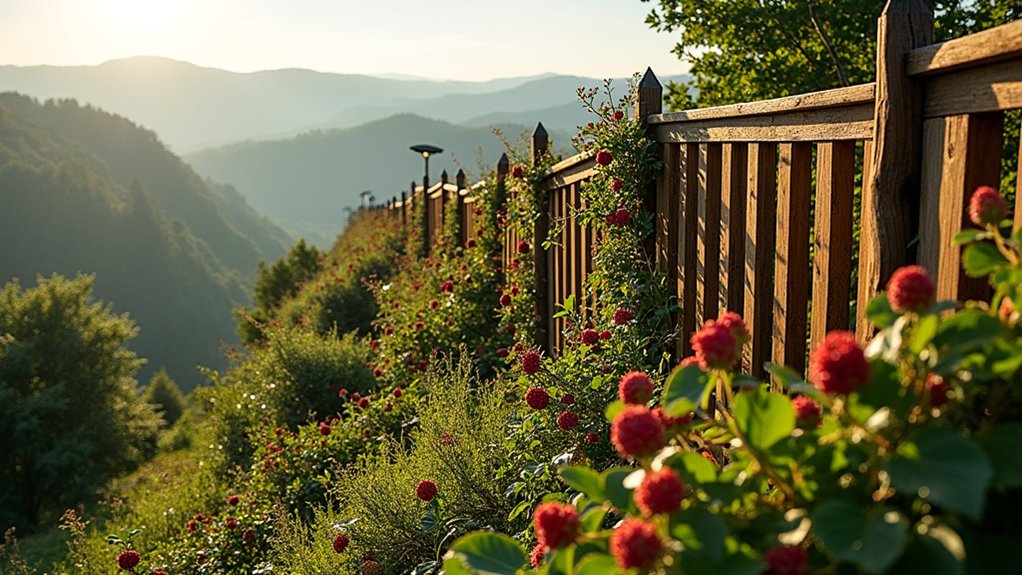
Transform your ordinary property boundary into a productive paradise with edible native berry terrace fencing.
You’ll create a privacy solution that doubles as a food source by incorporating American Elderberry, which grows 5-12 feet tall, alongside Blueberry and Blackberry varieties.
These native plants thrive in well-draining soil with full to partial sunlight, making them perfect for terraced designs that maximize sun exposure.
- Attracts beneficial wildlife, enhancing your property’s biodiversity
- Requires minimal maintenance once established, with natural drought resistance
- Combines functionality with sustainable food production
- Enhances your outdoor living space with seasonal visual interest
Your terraced berry fence will provide years of harvest while creating a unique landscape element that serves multiple purposes—beauty, privacy, and pantry all in one stunning solution.
Wildlife-Supporting Layered Plant Borders
Create a living sanctuary along your property lines by designing wildlife-supporting layered plant borders that serve as both beautiful boundaries and essential ecosystems.
By incorporating native species of varying heights and densities, you’ll establish diverse microhabitats that attract beneficial insects, birds, and mammals to your landscape.
Native layering creates a living tapestry, inviting nature’s helpers to find refuge within your garden’s edges.
Choose plants like Muhlenbergia lindheimeri and American Elderberry that require less water while providing food sources through nectar, berries, and seeds throughout different seasons.
These layered plant borders don’t just look stunning—they actively promote biodiversity and ecological balance in your yard.
You’ll enjoy the added benefits of reduced maintenance and water usage while your terraced fence design becomes a functioning wildlife corridor.
This approach transforms ordinary boundaries into thriving habitats that connect your property to the broader ecosystem.
Frequently Asked Questions
What Permits Might I Need Before Installing a Terraced Plant Fence?
You’ll typically need building permits for structural elements, zoning permits for property boundaries, and possibly HOA approvals. Check with your local planning department about height restrictions and setback requirements before starting your fence project.
How Do Terraced Native Plant Fences Perform During Extreme Weather Events?
Terraced native plant fences resist extreme weather well. They’ll stabilize soil during heavy rain, withstand wind better than solid barriers, and provide wildlife shelter during storms. Choose drought-resistant species for maximum resilience in all conditions.
What Is the Typical Installation Cost Compared to Traditional Fencing?
You’ll spend $20-40 per square foot for terraced native plant fences, compared to $15-30 for traditional fencing. They’re pricier upfront, but you’ll save on long-term maintenance and replacement costs.
Can Terraced Plant Fences Effectively Block Noise From Nearby Roads?
Yes, terraced plant fences can reduce road noise effectively. You’ll get best results with dense, layered plantings that create multiple sound barriers. They won’t block noise completely, but they’ll considerably dampen unwanted sounds.
How Long Until a Newly Installed Terraced Plant Fence Reaches Maturity?
Your terraced plant fence will reach maturity in 2-5 years, depending on plant species, climate, and care. You’ll see significant growth within the first season if you’re watering and maintaining it properly.
In Summary
You’ll find these native plant terraced fence solutions transform ordinary boundaries into living landscapes that serve multiple purposes. They’re not just beautiful privacy screens—they’re wildlife habitats, erosion controllers, and sustainable alternatives to traditional fencing. By selecting plants adapted to your region, you’ll create a low-maintenance, eco-friendly border that changes with the seasons and connects your property to the natural world around it.

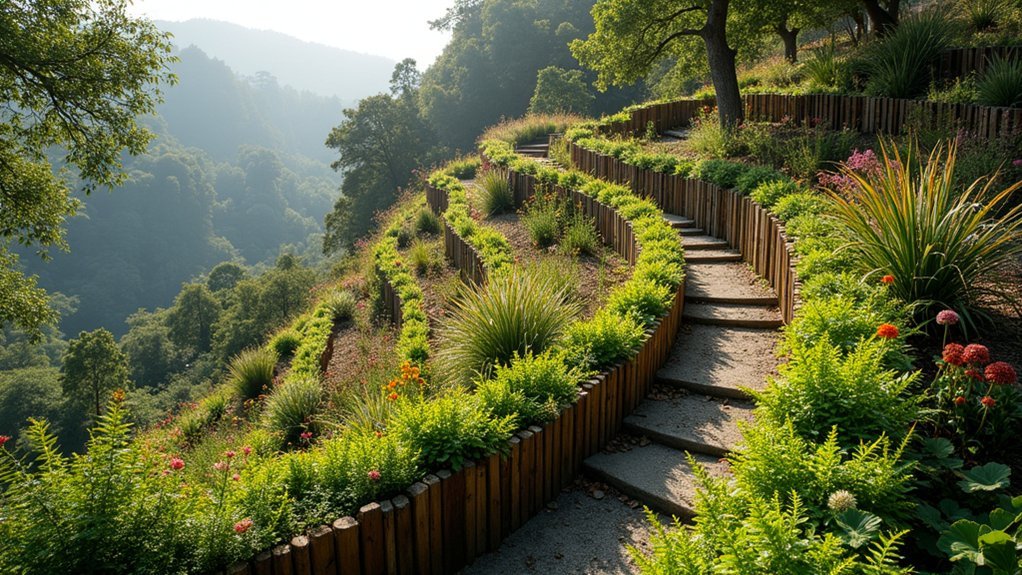



Leave a Reply